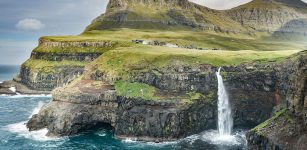Legend Of Marguerite de Bressieux: Brave Noblewoman Who Sought Revenge For Sexual Assault
A. Sutherland - AncientPages.com - They say it is only a legend, nothing more. You can believe it or not. Still, it could be a true story that could happen in any location at any time.
Ruins of Anjou Castle. The castle has a long history. With this castle is associated the memory of the Edict of Roussillon (August 8, 1564) by which Charles IX and Catherine de Medici imposed the date of January 1 as the first day of the year for the entire kingdom of France. Sold shortly after the Revolution, the castle of Anjou was largely destroyed between 1806 and 1813. Credit: Raydou - CC BY-SA 4.0
According to Humbert de Terrebasse (1842-1927), a lawyer and historian, this event took place during the Hundred Years' War (1337 - 1453), a struggle between England and France over a series of disputes, including the question of the legitimate succession to the French crown.
Ruins of Anjou Castle. The castle has a long history. With this castle is associated the memory of the Edict of Roussillon (August 8, 1564), by which Charles IX and Catherine de Medici imposed the date of January 1 as the first day of the year for the entire kingdom of France. Sold shortly after the Revolution, the castle of Anjou was largely destroyed between 1806 and 1813. Credit: Raydou - CC BY-SA 4.0
Marguerite de Bressieux was a French noblewoman born in Anjou, France, and lived in a castle with her parents.
The legend says that the castle was besieged and pillaged by rebel troops attempting to topple King Charles VII on behalf of a Burgundian nobleman, Louis de Chalon, the Prince of Orange.
Marguerite's father and mother were killed. The soldiers of Chalon raped her, her ladies-in-waiting, and other noblewomen. Marguerite buried the parents and then swore bloody revenge on Chalon and his ruthless men, whose shameless act proved to be the last they had committed.
However, they were not yet aware of what awaited them. Soon after the tragic incident, Marguerite and her ladies-in-waiting armed themselves and started military training that included riding in battle and sword fighting. Deeply motivated and ready to fight, they had only waited for the chance to encounter Chalon and his men in a competition.
Luckily, the women did not have to wait long. Finally, the king was ready to retaliate against Louis. When Marguerite heard that royal troops led by Raoul de Gaucort, governor of the Dauphiné, were being assembled to march against Chalon's soldiers, she made necessary preparations for the departure of her small group of female warriors in disguise.
Clad in black with faces covered with black scarves and with a pike or lance in one hand, they mounted their horses. One held a black banner decorated with heads superimposed over bones and silver tears. In the middle of these funeral emblems, there was an orange pierced by a spear, under which an inscription was visible: "Ainsi tu seras" ("Thus shall you be").
The orange was associated with Louis Chalon, the Prince of Orange.
Led by Marguerite de Bressieux, these brave women were perfectly aware of war risks and would not be denied their revenge.
At first, Gaucourt hesitated to allow Marguerite and her companions into his army but listened carefully to what the women had to say.
"Deign, noble lord, to accord us a place in your ranks. If our arms are weak, our hearts are strong and bent upon nothing but vengeance. Victims of the most cowardly, the most degrading outrage, we aspire to wash it out in blood." 1
Gaucort respected the determination of Marguerite and her companions and let them join the troops of King Charles VII on their way to encounter Chalon, Prince of Orange, and his men. Now a confrontation was imminent, and when it took place, Chalon's soldiers were surprised and could not believe their eyes.
They took the female warriors for frightening ghosts, who emerged from hell to take revenge on the living, but the women were real.
The black horse riders in disguise raised their visors before Chalon and his team. They bravely looked into the eyes of each of their rapists, who fled, terrified of fighting ghosts. They were chased by the royal troops who massacred them mercilessly, pushing the last of them into the Rhône River.
The legend further tells that Marguerite was deadly wounded in battle and had to wait for help for too long. Finally, her companions took her to a nearby convent, but she died several hours later.
She was buried with military funeral honors, and her companions decided to stay in the convent for the rest of their lives.
According to the legend, it happened in 1450 in France during the Hundred Years' War (1337-1453).
Updated on December 27, 2023
Written by – A. Sutherland - AncientPages.com Senior Staff Writer
Copyright © AncientPages.com All rights reserved. This material may not be published, broadcast, rewritten or redistributed in whole or part without the express written permission of AncientPages.com
Expand for referencesReferences:
- Schmermund E. Women Warriors
More From Ancient Pages
-
 Elizabeth Woodville: Mother Of The Princes In The Tower And Commoner Queen
Featured Stories | Jul 16, 2018
Elizabeth Woodville: Mother Of The Princes In The Tower And Commoner Queen
Featured Stories | Jul 16, 2018 -
 On This Day In History: American Archaeologist George A. Reisner Was Born – On Nov 5, 1867
News | Nov 5, 2016
On This Day In History: American Archaeologist George A. Reisner Was Born – On Nov 5, 1867
News | Nov 5, 2016 -
 Magnificent Pagodas In Indein Village And Undiscovered Secrets In The Myanmar Jungle
Featured Stories | Oct 9, 2020
Magnificent Pagodas In Indein Village And Undiscovered Secrets In The Myanmar Jungle
Featured Stories | Oct 9, 2020 -
 Rosicrucians’ Secret Knowledge Of Atlantis, Pyramids And Extraterrestrial Visitations
Ancient Mysteries | Apr 17, 2017
Rosicrucians’ Secret Knowledge Of Atlantis, Pyramids And Extraterrestrial Visitations
Ancient Mysteries | Apr 17, 2017 -
 Is There A Hidden Ancient Message Inside San Miniato Al Monte Basilica?
Featured Stories | Oct 3, 2022
Is There A Hidden Ancient Message Inside San Miniato Al Monte Basilica?
Featured Stories | Oct 3, 2022 -
 How Did The Early Rapa Nui People Put Huge Hats On Giant Statues Of Easter Island?
Ancient Technology | Jun 5, 2018
How Did The Early Rapa Nui People Put Huge Hats On Giant Statues Of Easter Island?
Ancient Technology | Jun 5, 2018 -
 Spearhead Mound – Destroyed Burial Place Of Adena Giants?
Featured Stories | Jun 1, 2021
Spearhead Mound – Destroyed Burial Place Of Adena Giants?
Featured Stories | Jun 1, 2021 -
 Arch Of Triumph In 2000-Year-Old City Of Palmyra – Destroyed
Archaeology | Oct 5, 2015
Arch Of Triumph In 2000-Year-Old City Of Palmyra – Destroyed
Archaeology | Oct 5, 2015 -
 Archaeological Discoveries At Fort San Juan Reveal Hidden History Of Conquistadors In American South
Archaeology | Mar 12, 2018
Archaeological Discoveries At Fort San Juan Reveal Hidden History Of Conquistadors In American South
Archaeology | Mar 12, 2018 -
 Utukku Lemnutu: Incantations Used As Therapy In Mesopotamia
Archaeology | Oct 25, 2016
Utukku Lemnutu: Incantations Used As Therapy In Mesopotamia
Archaeology | Oct 25, 2016 -
 Remote North Atlantic Islands Were Settled By An Unknown Group Of Humans Centuries Earlier Than Thought
Archaeology | Dec 27, 2021
Remote North Atlantic Islands Were Settled By An Unknown Group Of Humans Centuries Earlier Than Thought
Archaeology | Dec 27, 2021 -
 Monte d’Accoddi – Mesopotamian Ziggurat In Europe Built By King Of Uruk?
Featured Stories | Feb 5, 2018
Monte d’Accoddi – Mesopotamian Ziggurat In Europe Built By King Of Uruk?
Featured Stories | Feb 5, 2018 -
 Mysterious 2000-Year-Old Carved Vishap Stone Monuments Of Armenia
Featured Stories | Dec 13, 2016
Mysterious 2000-Year-Old Carved Vishap Stone Monuments Of Armenia
Featured Stories | Dec 13, 2016 -
 Fantastic Discovery At Hadrian’s Wall Reported By Archaeologists
Archaeology | Sep 10, 2022
Fantastic Discovery At Hadrian’s Wall Reported By Archaeologists
Archaeology | Sep 10, 2022 -
 Unique Chachabamba Complex Hidden In Peruvian Forest Reveals Its Secrets
Archaeology | Feb 7, 2019
Unique Chachabamba Complex Hidden In Peruvian Forest Reveals Its Secrets
Archaeology | Feb 7, 2019 -
 Thousands Of Roman Coins Found Across Europe Are Fake – Archaeologists Say
Archaeology | Jul 9, 2019
Thousands Of Roman Coins Found Across Europe Are Fake – Archaeologists Say
Archaeology | Jul 9, 2019 -
 Justinianic Plague Struck England Before It Reached Constantinople And It Did Not Wipe Out The Roman Empire
Archaeology | Nov 19, 2021
Justinianic Plague Struck England Before It Reached Constantinople And It Did Not Wipe Out The Roman Empire
Archaeology | Nov 19, 2021 -
 Mysterious Medieval Cemetery In Wales With People Buried In Unusual Positions Puzzles Archaeologists
Archaeology | Jan 3, 2024
Mysterious Medieval Cemetery In Wales With People Buried In Unusual Positions Puzzles Archaeologists
Archaeology | Jan 3, 2024 -
 Mythical Underground Labyrinth And Legendary Long-Lost Golden Tomb Found In Italy?
Featured Stories | Nov 21, 2024
Mythical Underground Labyrinth And Legendary Long-Lost Golden Tomb Found In Italy?
Featured Stories | Nov 21, 2024 -
 Huge Jars Unearthed In Kultepe, Turkey
Archaeology | Sep 27, 2015
Huge Jars Unearthed In Kultepe, Turkey
Archaeology | Sep 27, 2015


